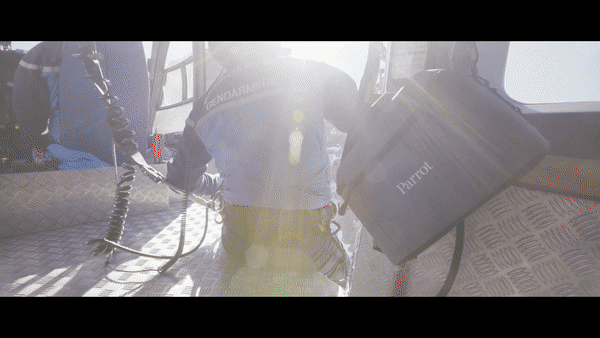Watch all the Transform 2020 sessions on-demand here.
Last summer, Paris-based Parrot took the wraps off Anafi, a fold-up, 4K-capable drone that weighs less than a pound and costs just $700. It’s targeted strictly at consumers, but today the company unveiled a new variant — Anafi Thermal — that’s equipped with a high-fidelity thermal sensor and custom software, which the company says make it an ideal fit for civil service professionals and rescuers, building and public works engineers, energy producers and transporters, and environmental preservationists.
Anafi Thermal packs the same hardware as its predecessor, including a robust carbon fiber frame filled with hollow glass microbeads. Its arms fold and unfurl in less than three seconds, and its gimbal-mounted 21-megapixel Sony IMX230 sensor can shoot up to 30 frames per second in 4K high dynamic range (HDR) at 100Mpbs, with lossless zoom of up to 1.4 times. That said, it’s a tad lighter at 315 grams (compared with the Anafi’s 325 grams), and has slightly slimmer folding arms and a 26-minute flight time (versus the original’s 25-minute flight time).
What’s new is the ability to view thermal and RGB images of surfaces, structures, and at-risk areas as Anafi Thermal flies over or under them. These images are recorded by a Flir sensor (with a 160 x 120 resolution) which can measure heat between 14 and 752 degrees Fahrenheit. (For the uninitiated, Flir supplies over 500,000 thermal sensors to automakers like General Motors, BMW, Audi, Mercedes-Benz, and Volkswagen for driver warning systems.) Drone pilots can measure the temperature of a specific part of an image, change color palettes, and more from Parrot’s companion app.

June 5th: The AI Audit in NYC
Join us next week in NYC to engage with top executive leaders, delving into strategies for auditing AI models to ensure fairness, optimal performance, and ethical compliance across diverse organizations. Secure your attendance for this exclusive invite-only event.
“The drone’s unique imaging capabilities allow professionals to take immediate action or analyze recorded photos and videos in unprecedented detail,” Anafi wrote in a press release. “Anafi Thermal collects relevant and previously inaccessible data with complete security, improving the return on investment, efficiency, and productivity for professionals in multiple industries.”
Anafi Thermal will be available beginning May 2019 for $1,900.

The drone has stiff competition in DJI’s $2,000 Mavic 2 Enterprise, a solution tailor-made for firefighting; law enforcement; emergency response; and inspection of powerlines, cell towers, and bridges. The Mavic 2 is less portable but has a higher top speed (45 miles per hour versus Anafi’s 33 miles per hour) and longer battery life (31 minutes versus 25 minutes), plus 10 optical avoidance sensors and a 12-megapixel, 1/2.3-inch gimbal-stabilized sensor with up to 2 times optical and 3 times digital zoom that can shoot up to 4K.
Perhaps the highlight of the Mavic 2 Enterprise is an extender port that allows pilots to connect modular accessories to its frame, like M2E Beacon, a dual flashlight that provides up to 2,400 lumens; the M2E Speaker, a loudspeaker that can play up to 10 prerecorded voice messages; and the M2E Beacon, an ultra-bright LED that DJI says makes the Mavic 2 Enterprise easier to spot from miles away. All three come bundled in the box, along with a remote controller, a spare battery, and a protection kit with flight tools.
Companies like AT&T use drones for maintenance inspections and to assist in natural disaster zones, and dozens of local government agencies, like the San Diego Fire Department (SDFD), have begun actively deploying drones as part of the Federal Aviation Administration’s (FAA) unmanned aerial systems integration pilot program. In May, the FAA chose 10 winners from a pool of more than 160 applicants interested in reimagining how drones can be used by governments and private industry. Meanwhile, telepresence drone piloting company Cape and others in the industry have begun to partner with first responders like the Chula Vista Police Department and San Diego Fire Department for field tests.
Reports show that the commercial drone industry is continuing to grow quickly, albeit from a small base. A 2017 forecast from Gartner projected the number of commercial drones sold that year would exceed 174,000. Moreover, about $454 million was thrown at UAV startups in 2016 alone, and the market is forecast to become a $127 billion industry by 2020.


